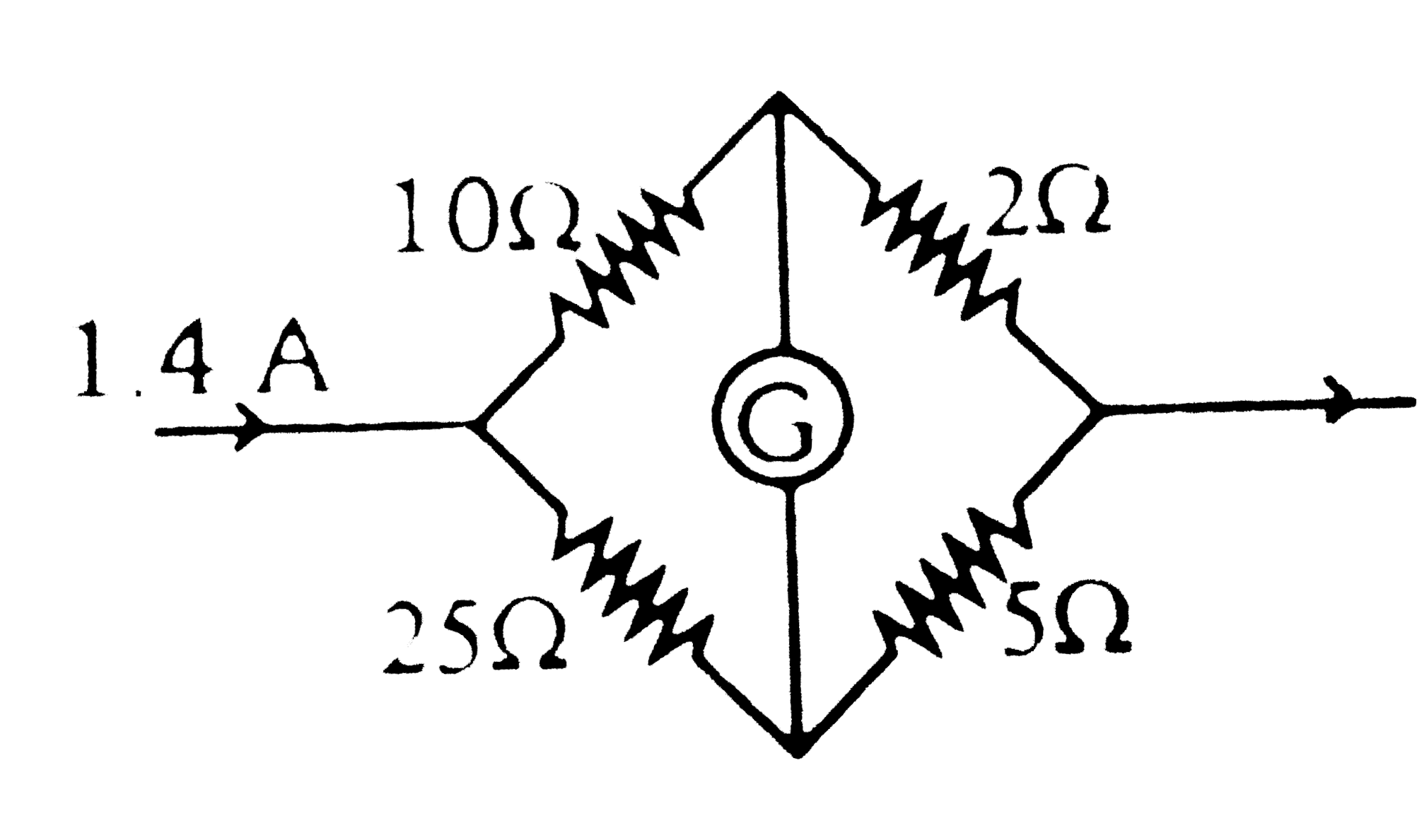A galvanometer of resistance 20Ω is shunted by a 2Ω resistor. What part of the main current flows through the galvanometer ?
To solve the problem of finding the part of the main current that flows through the galvanometer when it is shunted by a resistor, we can follow these steps:
1. Identify the Resistances:
- The resistance of the galvanometer (R_g) is 20 Ω.
- The resistance of the shunt resistor (R_s) is 2 Ω.
2. Understand the Circuit Configuration:
- The galvanometer and the shunt resistor are connected in parallel. In a parallel circuit, the voltage across both components is the same.
3. Apply Ohm's Law:
- For the galvanometer, the current through it (I_g) and the voltage across it can be expressed as:
V=Ig⋅Rg
- For the shunt resistor, the current through it (I_s) can be expressed as:
V=Is⋅Rs
4. Set the Voltages Equal:
- Since the voltage across both resistances is the same, we can set the equations equal to each other:
Ig⋅Rg=Is⋅Rs
5. Express I_s in Terms of I_g:
- Rearranging the equation gives:
Is=RgRs⋅Ig
- Substituting the values of R_g and R_s:
Is=20Ω2Ω⋅Ig=10⋅Ig
6. Calculate Total Current (I):
- The total current (I) flowing through the circuit is the sum of the currents through the galvanometer and the shunt:
I=Ig+Is=Ig+10⋅Ig=11⋅Ig
7. Find the Fraction of Current through the Galvanometer:
- The fraction of the total current that flows through the galvanometer can be expressed as:
Fraction=IgI=Ig11⋅Ig=111
8. Convert to Percentage:
- To express this fraction as a percentage, multiply by 100:
Percentage=(111)⋅100≈9.09%
Final Answer:
Approximately 9.09% of the main current flows through the galvanometer.
- The resistance of the galvanometer (R_g) is 20 Ω.
- The resistance of the shunt resistor (R_s) is 2 Ω.
- The galvanometer and the shunt resistor are connected in parallel. In a parallel circuit, the voltage across both components is the same.
- For the galvanometer, the current through it (I_g) and the voltage across it can be expressed as:
V=Ig⋅Rg
- For the shunt resistor, the current through it (I_s) can be expressed as:
V=Is⋅Rs
- Since the voltage across both resistances is the same, we can set the equations equal to each other:
Ig⋅Rg=Is⋅Rs
- Rearranging the equation gives:
Is=RgRs⋅Ig
- Substituting the values of R_g and R_s:
Is=20Ω2Ω⋅Ig=10⋅Ig
- The total current (I) flowing through the circuit is the sum of the currents through the galvanometer and the shunt:
I=Ig+Is=Ig+10⋅Ig=11⋅Ig
- The fraction of the total current that flows through the galvanometer can be expressed as:
Fraction=IgI=Ig11⋅Ig=111
- To express this fraction as a percentage, multiply by 100:
Percentage=(111)⋅100≈9.09%
Approximately 9.09% of the main current flows through the galvanometer.
Topper's Solved these Questions
- MOVING CHARGES AND MAGNETISMBOOK - AAKASH SERIESCHAPTER - MOVING CHARGES AND MAGNETISMEXERCISE - EXERCISE-IA
142 Videos
- MOVING CHARGES AND MAGNETISMBOOK - AAKASH SERIESCHAPTER - MOVING CHARGES AND MAGNETISMEXERCISE - EXERCISE-IB
71 Videos
- MOTION IN A STRAIGHT LINE BOOK - AAKASH SERIESCHAPTER - MOTION IN A STRAIGHT LINE EXERCISE - very Short answer type question
15 Videos
- NUCLEAR PHYSICSBOOK - AAKASH SERIESCHAPTER - NUCLEAR PHYSICSEXERCISE - ADDITIONAL PRACTICE PRACTICE SHEET (ADVANCED) Integer Type Questions
3 Videos
Similar Questions
We have a galvanometer of resistance 25Ω. It is shunted by a 2.5Ω wire. The part of total current that flows through the galvanometer is given as
View SolutionA galvanometer of resistance 150 ohm is shunted such that only 1/11 of the main current flows through the galvanometer. The resistance of the shunt is, (in ohm)
View SolutionA galvanometer has resistance 36Ω if a shunt of 4Ω is added with this, then fraction of current that passes through galvanometer is:
View SolutionA galvanometer of resistance G is shunted by a resistance Sohm. To keep the main current in the circuit uncharged, the resistnace to be put in series with the galvonmeter
View SolutionA moving coil galvanometer of resistance 100Ω is used as an ammeter using a resistance 0.1Ω. The maximum diflection current in the galvanometer is 100μA. Find the minimum current in the circuit so that the ammeter shows maximum deflection
View SolutionA moving coil galvanometer has a resistance of 990Ω. in order to send only 10% of the main currect through this galvanometer, the resistance of the required shunt is
View SolutionCalculate the current flows through resistance 2Ω.

View SolutionA galvanometer has a resistance of 3663Ω. A shunt S is connected across it such that (1/34) of the total current passes through the galvanometer. Then the value of the shunt is
View SolutionA galvanometer has a resistance of 3663Ω. A shunt S is connected across it such that (1/34) of the total current passes through the galvanometer. Then the value of the shunt is
View SolutionA galvanometer having a resistance of 8 ohm is shunted by a wire of resistance 2 ohm . If the total current is 1 amp , the part of it passing through the shunt will be
View Solution
